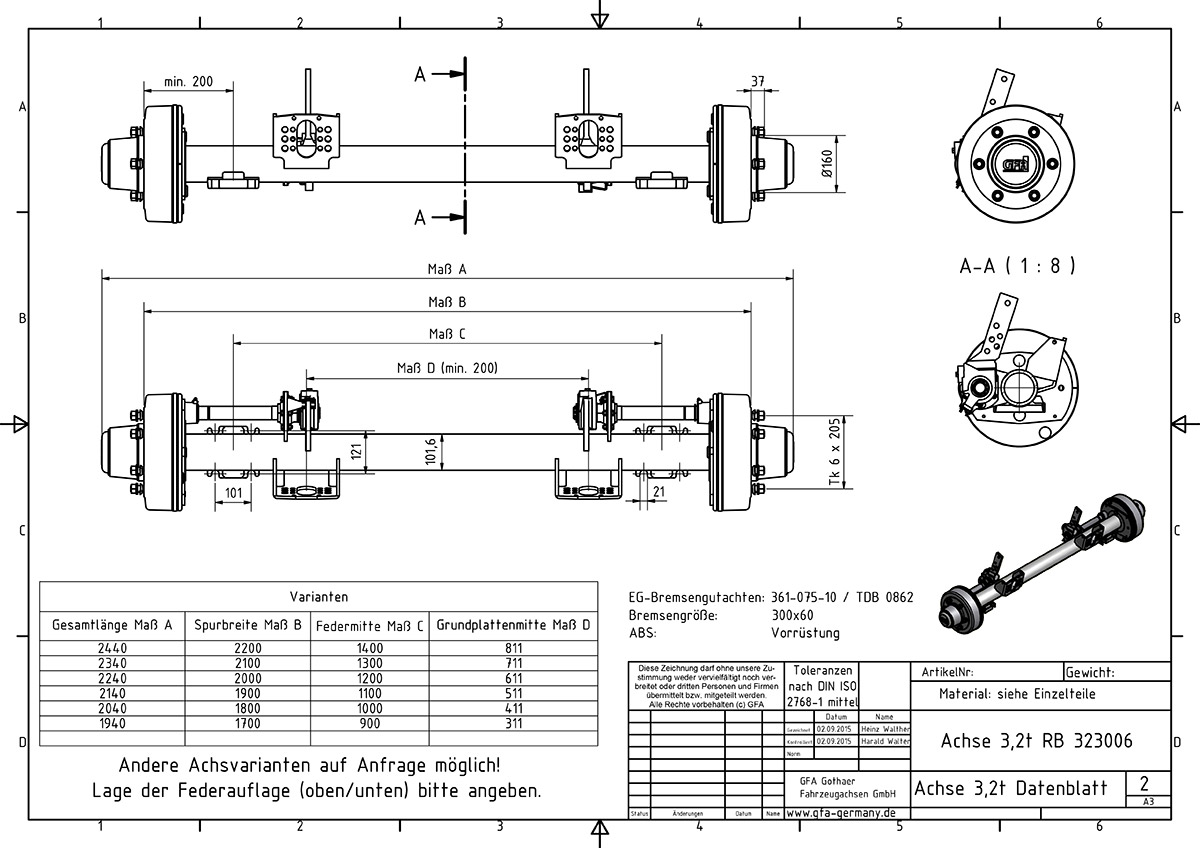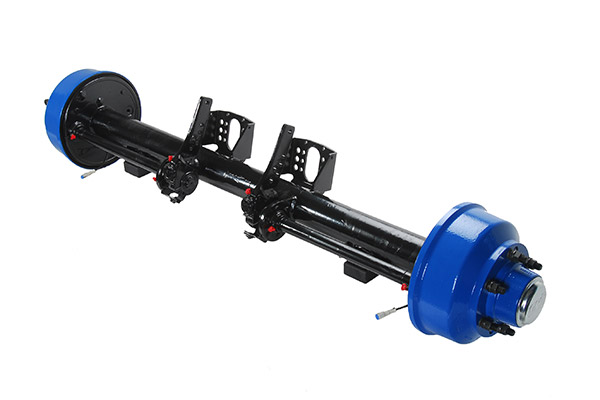GFA Gothaer Fahrzeugachsen is internationally renowned for the development and distribution of rigid commercial vehicle axles for towed vehicles.
What is a rigid axle?
A rigid axle is part of the wheel suspension of a vehicle. Regardless of whether it is a car, truck, train, tractor, motorbike or similar, all vehicles require a mechanical decoupling of the wheel carrier, in this case the axle, from the vehicle body, i.e. the body with the passenger cell, etc. This ensures that shocks and vibrations from the road are not passed on directly to the vehicle body. This means that shocks and vibrations from the road are not directly transmitted to the body, which increases comfort, durability and driving safety. Translated with www.DeepL.com/Translator (free version)
How is a rigid axle constructed?
The decoupling is provided by a shock- and vibration-absorbing system consisting of a spring (helical compression spring, leaf spring, air spring) and damper. In addition, permanent positioning of the axle at each point of deflection under the body is required, which is made possible with link constructions (wishbones, trailing arms, etc.).
Rigid axles connect the wheels to each other transversely to the direction of travel. Components of a rigid axle are
- the axle beam,
- the brakes (drumor disc brake),
- Connection points for the wheel guide,
- Suspension,
- Damping and
- Connections and
- Sensors for actuating the braking device.
The rigid structure allows movement in two degrees of freedom: Longitudinal movement in the height direction and rotary movement in the longitudinal axis of the vehicle.
6 Thousand years of success story
The rigid axle has its origins in simple chariots that have been driven since the middle of the 4th millennium BC. From the 2nd millennium BC, the Sumerians in the Central Asian region were the first to use single-axle chariots, which were used and expanded in the course of the Bronze Age and Antiquity, mostly for military purposes. Later, they were also used for representational and competitive purposes. By 500 BC, chariots had spread as far as Western and Northern Europe, North Africa, East and South Asia. In the Middle Ages, the first carriages with rigid axles and leaf suspension appeared. Since the invention of the combustion engine in 1886, rigid axles have finally also been used in automobiles. Translated with www.DeepL.com/Translator (free version)
Independent suspension vs. rigid axle
In addition to the conventional rigid axle, there is also independent suspension. Depending on the application, each principle has its advantages and disadvantages. In the heavy commercial vehicle sector of towed vehicles, the primary objective is to protect the goods from damage and to ensure driving stability at all times, regardless of the driving situation. The rigid axle is very suitable for this purpose because, in addition to the above-mentioned properties, it is also very robust and durable, can also be used in compact installation spaces due to its flat design and can be offered and maintained at a low price due to its simple design.
Nowadays, the rigid axle is still very common in the commercial vehicle sector. Only the steered front axle of powered towing vehicles and larger dropdeck trailers for heavy transport are usually suspended individually. In the passenger car sector, 22.5% of all vehicles under 3.5 t are still equipped with a rigid rear axle. In motorsport, the rigid axle is still prescribed by the regulations in the NASCAR series.
Order your rigid axle from GFA
You can order rigid axles incl. wheel suspension and various accessories for the load range between 3.2 t and 7.5 t. We offer complete axles as well as half axles and axle stubs in braked design or as pure running axle.
An axle is attached to the axle unit via the spring supports. To actuate the brake, base plates are provided by means of which the pneumatically controlled brake cylinders exert pressure on the slack adjusters in order to generate the braking force via the camshaft deflection. The slack adjusters can be installed completely or shortened depending on the installation space capacity. In accordance with the available rim dimensions, GFA offers wheel connection sizes with a bolt circle of 205 mm 6 for drum brakes or 225 mm x10 for disc brakes with a centre centring of 160 mm for drum braked and 175 mm for disc braked axles. In addition, the wheel studs with thread M18x1.5 for drum brakes and M22x1.5 for disc brakes can be ordered with centring rings.
Our axle units can be ordered for different ride heights (dimension between frame connection and axle centre). The axle can be mounted under the spring unit as LAO 1 with a ride height of 454 mm and LAO 2 with a ride height of 554 mm. It is also possible to order the axle above the handlebar or spring assembly as version LAU 1 (ride height 249 mm), LAU 2 (349 mm) or LAU K (180 mm).
The advantage of an air suspension unit is the height adjustability and the higher stability in curves and under braking. If required, the axle can also be supplied in combination with a leaf spring package as a single or tandem unit.




